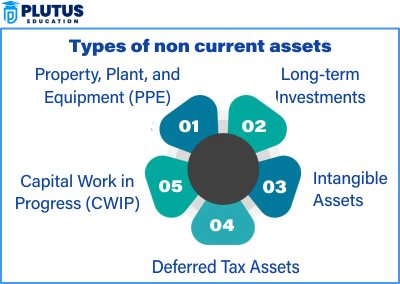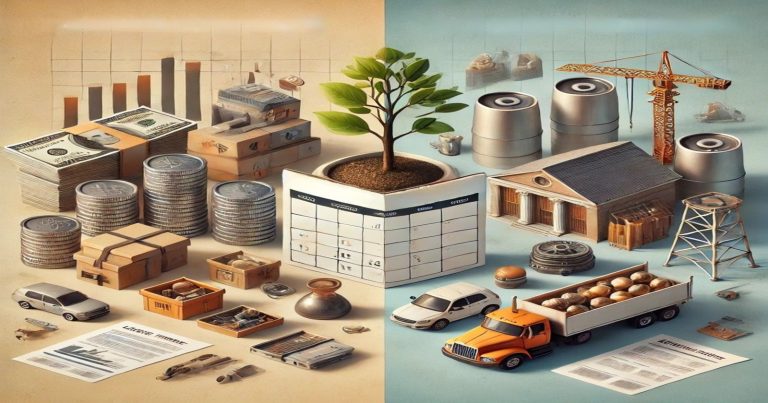Every student studying finance and accounting needs to learn the idea of what the current asset is and what the non-current asset is. These terms refer to the goods, the money and the bigger things like buildings or machines and make people aware whether a company did well in its finances or not. As a matter of fact, current asset and non current asset are a business’ whole wealth. However, they are not one and the same.
Current assets are the items that a business will use, sell or change into money within a year’s time. They include cash, stock, and the money that customers owe to the business. Non-current assets are things a company keeps for a long time, such as land or the machines used to run the business. These assets are the ones that make the Business Functional for many years to come.
The difference between current asset and non current asset doesn’t lie in the fact whether a business has or doesn’t have them. Current assets are short-term assets of a business. Non-current assets are long-term assets. Indian students should become proficient with this topic in their accounting basics. It is a help in exams and also in real-life business. You have to know what the types of assets are if you want to run a company or become an accountant. It helps you to make better money decisions, prepare a balance sheet, and verify the condition of a business.
Difference Between Current Asset and Non Current Asset
Every corporation possesses one or more goods. Yet not all these goods are the same. Thus we group them into two categories – current asset and non current asset. This is how one can determine what will bring in money shortly and what will not help until later.
A current asset is an item that a business will be able to sell or use in one year. A non-current asset is a thing a company will maintain and use for the few coming years. This is the big line of separation. However, there are more situations, like time, target, and purpose, in which some very different asset uses may occur that define their variable nature.
| Feature | Current Asset | Non Current Asset |
| Time of Use | Within one year | More than one year |
| Example | Cash, Inventory, Accounts Receivable | Land, Building, Machinery |
| Liquidity | Very High | Low |
| Shown in Balance Sheet | Under Current Assets section | Under Non-Current Assets section |
| Role in Business | Helps with daily operations | Helps with long-term growth |
| Depreciation | Not applicable usually | Depreciation applies (except land) |
Why the Difference Matters
- Assists in determining at what speed a firm can settle bills.
- Aids in the efficient handling of working capital.
- Enables banks to make a lending decision.
- Shows that the company is going to be a strong one, far into the future
Real-Life Example for Indian Students
Current assets are the stock and cash which a kiran store has of ₹50,000 and ₹10,000 respectively. The non-current assets of the entity comprise of the fridge worth ₹20,000 and a shop building.
What are Current Assets?
Current assets include the things which a company plans to utilize, sell, or convert into cash within one year. These are useful in day-to-day activities. Without the company’s current assets, the company might not be able to pay the bills, procure goods, or keep on with the daily business operations. It is similar to a car running on fuel. They are the ones who are responsible for ensuring the business processes run on a day-by-day basis.
These assets are quite liquid. That is to say, they can be converted to cash relatively quickly. Every Indian student who majors in business or commerce should be familiar with the term current assets. They are listed at the top of the balance sheet. They also be helpful in the process of working capital computation.
Features of Current Assets
- Short life span (less than 1 year)
- Make it possible to stay less time.
- Execute transactions within banking ATMs or ITMs as simple as that.
- Have the rest of the money to the shopping center match the job
Importance of Current Assets in a Business
- Pay off short-term debts.
- Ensure smooth business operations. Improve credit by paying within the due date
- Enable the Management to make quick decisions
For instance, a company that has a huge pile of cash may be able to pay salaries, rent, or purchase more of the products all with much ease. In case the company is not being able to include more current money, that company may face trouble in paying the expenses.
Types of Current Assets
Every business is dependent on current assets. It is these which ensure daily operations continue smoothly. If a business should lack current assets, the result is that it will go bankrupt. For a student to succeed in studying, they need to know different kinds of current assets. These can then be used primarily to satisfy urgent requirements.
A company plans to use, sell, or convert them into cash within a year. They are very liquid and thus they get turned into cash very quickly.In India, the variety of companies, including small shops, one-man shops, and the big ones, all rely on current assets. These assets use the money to pay bills, purchase goods, inflate salaries, and also generate income. Additionally, they give information on the ability of a business to survive in the short run. Now, let’s check out each type of current asset precisely.
1. Cash and Cash Equivalents
The most liquid of assets is cash. Cash is necessary for firms to operate day by day and be in proper functioning. These are the most popular forms of cash such as:
- Money in hand (notes and coins)
- Money in bank accounts (savings and current)
- Cheques ready to be deposited
- Demand drafts Bank deposits less than 3 months
Cash equivalents are the types of investments that can be converted into cash very easily and quickly. These instruments include treasury bills, commercial papers, and certificates of deposit.
To illustrate, a shop in Mumbai puts ₹10,000 in cash to buy stock. This shows that cash is a current asset. The cash also helps to pay salaries, rent, utility bills, and transport. Right? A company will not be able to work properly if it’s out of cash and thus the cash and cash equivalents will come first in the balance sheet.
2. Accounts Receivable (Debtors)
When a company sells products on credit, the customers require time to pay. The amount that is not paid by the customers is called accounts receivable. In India, it is also known as debtors.
- If a company, for example, sells goods to a customer with the credit, the company will receivable ₹5,000. This money will convert into cash in a few weeks or few months.
- Receivables are crucial in companies. They depict how much revenue will a business get. However, there are also risks. Sometimes, customers do not pay on time. Therefore, companies watch their receivables very closely.
Indian companies frequently offer 30 or 60 days credit to the buyers. This is the key to the rotation of the market but it should be managed carefully. High receivables imply more sales, but also higher risk.
3. Inventory (Stock)
Inventory, in many companies, is basically the most important asset of the company and it is a product for sale. The following are some examples:
- Raw materials
- Work-in-progress (unfinished goods)
- Finished goods (ready to sell)
For instance, there are 500 shirts in a shop. This is the inventory. A plant which has cotton fabric is a part of raw material inventory. Inventory is the backbone of the supply chain. It is an important factor. That is, if it is too high, the money will be blocked, and if it is too low, it will result in a decrease in sales.
Stock management is very critical to business. One of the main reasons for this is because if inventory is too high, cash flows will be blocked otherwise, it will lead to a decrease in sales.
The e-commerce industry, which is gaining popularity in India, is dependent on inventory. In addition to e-commerce suppliers, retail stores, and grocery stores are among those that are most dependent on it.
4. Marketable Securities
Marketable securities are investments that a company can quickly sell. Some of these are:
- Short-term government bonds
- Mutual fund units
- Public company shares
The company is buying these to make small profits or keep the extra money safe. But The lifespan of these is not long; they are bought and sold within a year. Marketable securities are a safe and liquid way of making a profit for companies.
For instance, a company pays ₹1,00,000 to acquire may later sell the shares as a current asset so, it is a current asset.
5. Prepaid Expenses
Occasionally, companies make payments before using the service. This payment is a prepaid expense. They are also current assets because the company will receive the value shortly. Often, Indian companies pay rent or insurance in advance. These are listed under current assets up to the time of consumption of the facility.
6. Short-Term Loans and Advances
A current asset is a business that loans employees or suppliers on the assurance that it will be paid back within a year. Moreover, this also consists of:
- Pre-payments to suppliers
- Short-term deposits
- Advances for expenses
For example, a business gives ₹20,000 to a vendor for raw material. The vendor will deliver goods in two weeks. That amount is recorded as a short-term advance. Such loans and advances are common in India. Many companies give short-term support to keep operations smooth.
| Type of Current Asset | What It Includes | Why It Matters |
| Cash and Cash Equivalents | Cash in hand, bank, and short deposits | Used daily for all payments |
| Accounts Receivable | Money due from customers | Shows future cash inflow |
| Inventory | Goods ready to sell or in process | Supports sales and production |
| Marketable Securities | Shares, bonds, mutual funds | Easy to convert into cash |
| Prepaid Expenses | Rent, insurance, or services paid in advance | Gives future benefits |
| Short-Term Loans & Advances | Employee loans, vendor advances | Keeps business going smoothly |
What are Non-current Assets?
Non-current assets are the assets that a business holds for a long period, which is usually over one year. They help the company in production, sales, and operations many years to come. These assets are not used up quickly. They are slow to sell or convert into cash. But they give long-term benefits. In India, most factories, shops, and companies have huge long-term assets like land, building, and machines.
Non-current assets are displayed in the second section of the balance sheet. Some of them diminish in value with time (depreciation), while some (like land) do not.
Features of Non Current Assets
- The use of the property over a period of more than one year.
- Is the property an Investment that Creates Money for Many Years.
- The allocation of non-residential property is subtracted from its historical cost, excluding land.
- In current assets, land is eliminated by cash flow.
Why Non-Current Assets Matter
- Construct a solid platform for business
- Aid in procurement of a loan or an investment
- Amplify the asset value
- Demonstrate progress and potential of the business
Example in Real Life
If a school buys a building or a college buys computers, these are non-current assets. They help for many years, not just a few months.

Types of Non Current Assets
Among various categories of non-current assets (or long-lived assets) we find the role-playing types. They come in two forms: physical (tangible) and non-physical (intangible). Speak to every part of your being with the help of this guide to Non-Current.
1. Property, Plant, and Equipment (PPE): This can consist of real assets such as buildings, machines, land and vehicles. These are the main working tools of a business. They are used daily but not sold quickly.
2. Intangible Assets
These are intangible assets. These may consist of the following:
- Patents
- Trademarks
- Copyrights
- Brand Value
- Goodwill
They form the image of a company and customer loyalty.
3. Long-term Investments: One of the possible long-term investments of a company could be if the company buys shares or bonds and plans to hold them for years, then the company would list those shares or bonds as non-current asset.
4. Deferred Tax Assets: It to can be seen that a company may either pay more tax in a particular tax year or have it to be refunded to him in the future. By recording, either of these is made the company’s tax liability a non-current asset.
5. Capital Work in Progress (CWIP): Money spent that particular will not be put into use on the construction job of Jay is an instance of capital work in progress.
Relevance to ACCA Syllabus
Current and non-current assets are the topic of Financial Accounting (FA) and Financial Reporting (FR) in ACCA. Candidates are expected to fully comprehend the accounting treatment of each type of asset under IFRS and their preparation of an accurate statement of financial position as well as measurement principles such as depreciation and inventory valuation. This is a basic requirement in case analysis studies, consolidated statements, and real-life accounting implications.
Current Asset vs Non Current Asset ACCA Questions
Q1: According to IAS 1, assets are classified in the statement of financial position as:
A) Operating and Non-operating
B) Current and Non-current
C) Tangible and Intangible
D) Revenue and Capital
Ans: B) Current and Non-current
Q2: The following is a current asset according to IAS 1:
A) Goodwill
B) Leasehold Building
C) Cash and Cash Equivalents
D) Trademark
Ans: C) Cash and Cash Equivalents
Q3: What is the typical feature of non-current assets?
A) Sold within one year
B) Used to pay short-term obligations
C) Give economic benefit more than one year
D) Kept for trading
Ans: C) Give economic benefit more than one year
Q4: Which of the following would not be a current asset?
A) Prepaid Rent
B) Accounts Receivable
C) Inventory
D) Land
Ans: D) Land
Q5: What is the treatment of intangible non-current assets under IAS 38?
A) Written off in full in the year it was incurred
B) Not included in financial statements
C) Amortized if they have a finite useful life
D) Revalued annually irrespective of impairment
Ans: C) Amortized if they have a finite useful life
Relevance to US CMA Syllabus
Financial Planning, Performance, and Analytics, CMA students is required to comprehend the responsibility of the asset division and to value those assets in inspecting the companies cometh, the strength of the company, and its long-term investment forecast.
Current Asset vs Non Current Asset US CMA Questions
Q1: Which of the following would most likely be included in working capital calculation?
A) Long-term loan
B) Accounts Receivable
C) Building
D) Bonds Payable
Ans: B) Accounts Receivable
Q2: Which asset is considered a non-current asset for a manufacturing firm?
A) Raw Material
B) Accounts Receivable
C) Machinery
D) Cash
Ans: C) Machinery
Q3: In calculating operating cash flow, which of the following is a current asset adjustment?
A) Depreciation
B) Inventory changes
C) Land purchase
D) Equipment sale
Ans: B) Inventory changes
Q4: Which of these affects a company’s current ratio?
A) Issue of long-term debt
B) Purchase of fixed asset with cash
C) Collection of receivables
D) Depreciation expense
Ans: C) Collection of receivables
Q5: What describes the liquidity of current assets?
A) They must be amortized
B) They cannot be converted into cash
C) They convert into cash within a year
D) They are recorded only at historical cost
Ans: C) They convert into cash within a year
Relevance to US CPA Syllabus
In the fiscal bookkeeping and the issuance of (FAR) Important Administration, the candidates are supposed to separate the assets, execute regular and non-current capital GAAPs and learn their impact on the financial statements as well as the ratios. Inaccurate reporting and audit procedures are supported by a thorough understanding.
Current Asset vs Non Current Asset US CPA Questions
Q1: What is the key difference between current and non-current assets in US GAAP?
A) Their nature
B) Their liquidity
C) Their ownership
D) Their insurance coverage
Ans: B) Their liquidity
Q2: Which of the following is a current asset under US GAAP?
A) Patent
B) Inventory
C) Deferred Tax Asset (long-term)
D) Plant & Equipment
Ans: B) Inventory
Q3: A company sells goods on credit. How should this be classified?
A) Non-current Asset
B) Revenue
C) Current Liability
D) Accounts Receivable (Current Asset)
Ans: D) Accounts Receivable (Current Asset)
Q4: Which asset typically undergoes depreciation?
A) Inventory
B) Building
C) Trademark
D) Prepaid Insurance
Ans: B) Building
Q5: Which of the following is most likely to appear under non-current assets?
A) Accrued Income
B) Leasehold Land
C) Inventory
D) Prepaid Rent
Ans: B) Leasehold Land
Relevance to CFA Syllabus
In the presentation of balance sheet, liquidity analysis and the valuation of assets are the basic concept that a topic in the CFA Level I Financial Reporting & Analysis will deal with. Ratios are employed for both common and non-current items in order to create a proper estimate for the company.
Current Asset vs Non Current Asset CFA Questions
Q1: What is the purpose of classifying assets as current or non-current?
A) For inventory control
B) For tax planning
C) For liquidity and solvency analysis
D) For budgeting
Ans: C) For liquidity and solvency analysis
Q2: In financial analysis, which of the following is not a current asset?
A) Cash
B) Marketable Securities
C) Equipment
D) Inventory
Ans: C) Equipment
Q3: Which financial ratio uses current assets in its calculation?
A) Debt-to-equity ratio
B) Quick ratio
C) Return on Equity
D) Asset Turnover Ratio
Ans: B) Quick ratio
Q4: Which asset increases operating cycle length if it grows too much?
A) Land
B) Goodwill
C) Accounts Receivable
D) Copyright
Ans: C) Accounts Receivable
Q5: Which of the following is considered an illiquid asset?
A) Cash
B) Inventory
C) Land
D) Treasury Bills
Ans: C) Land


